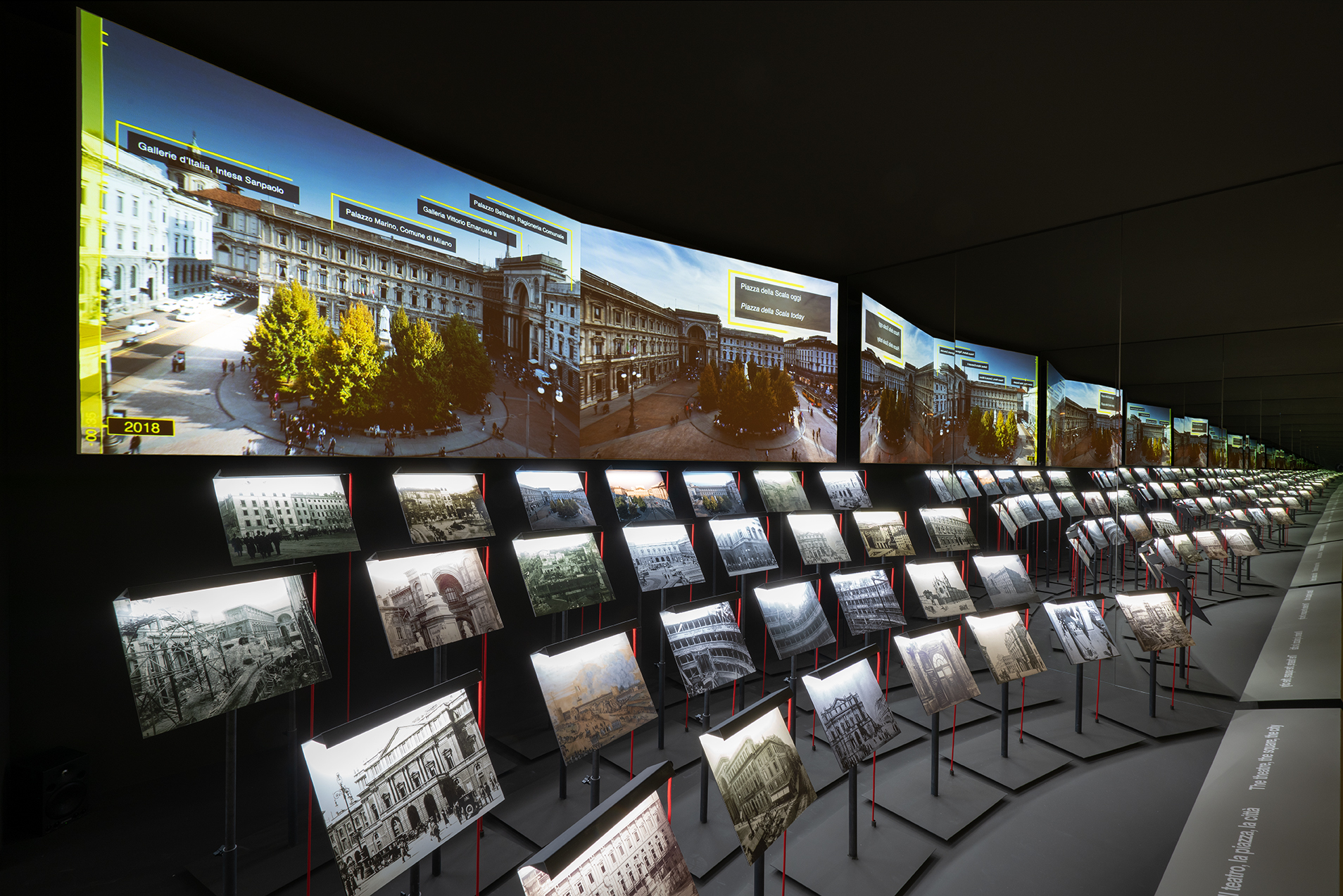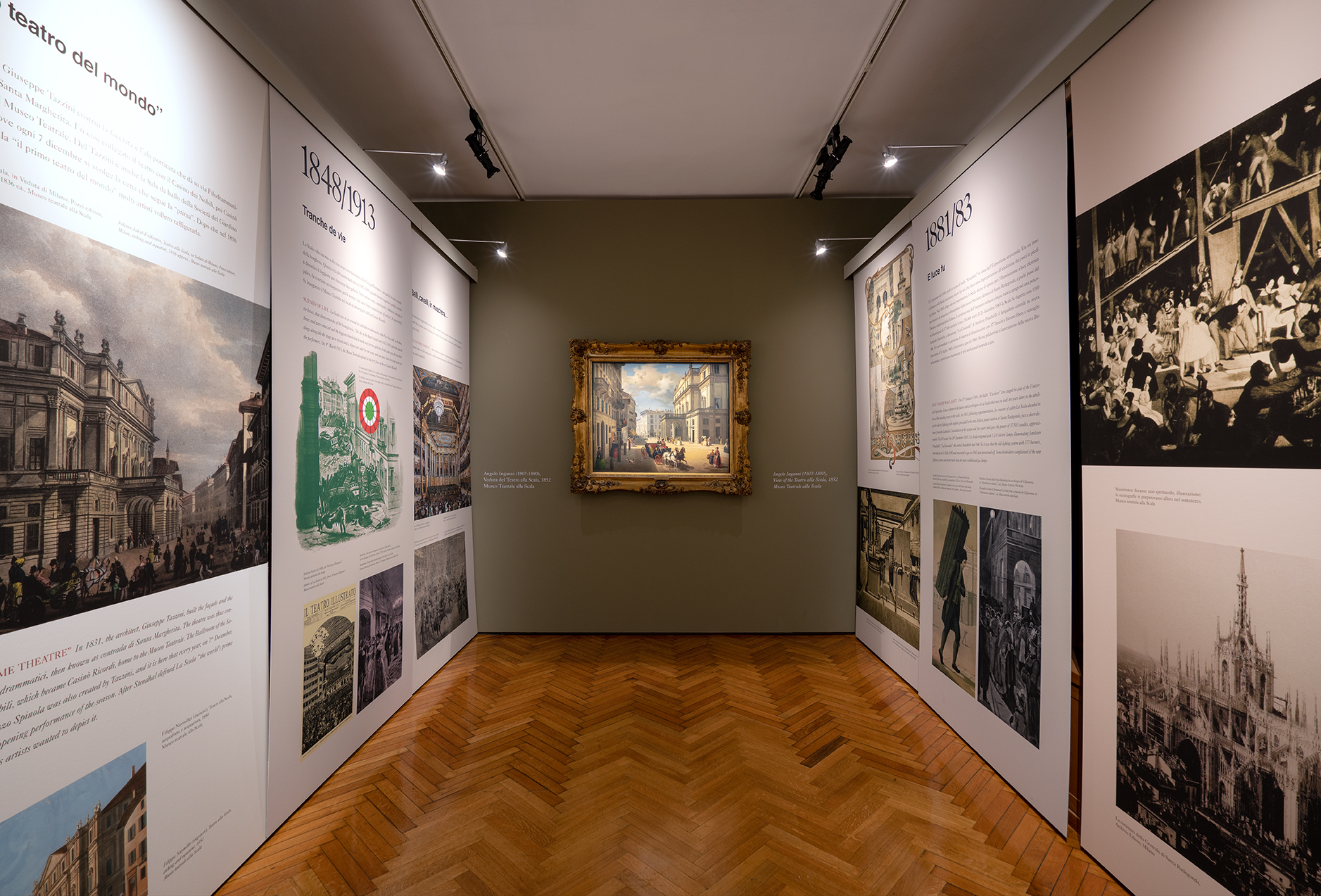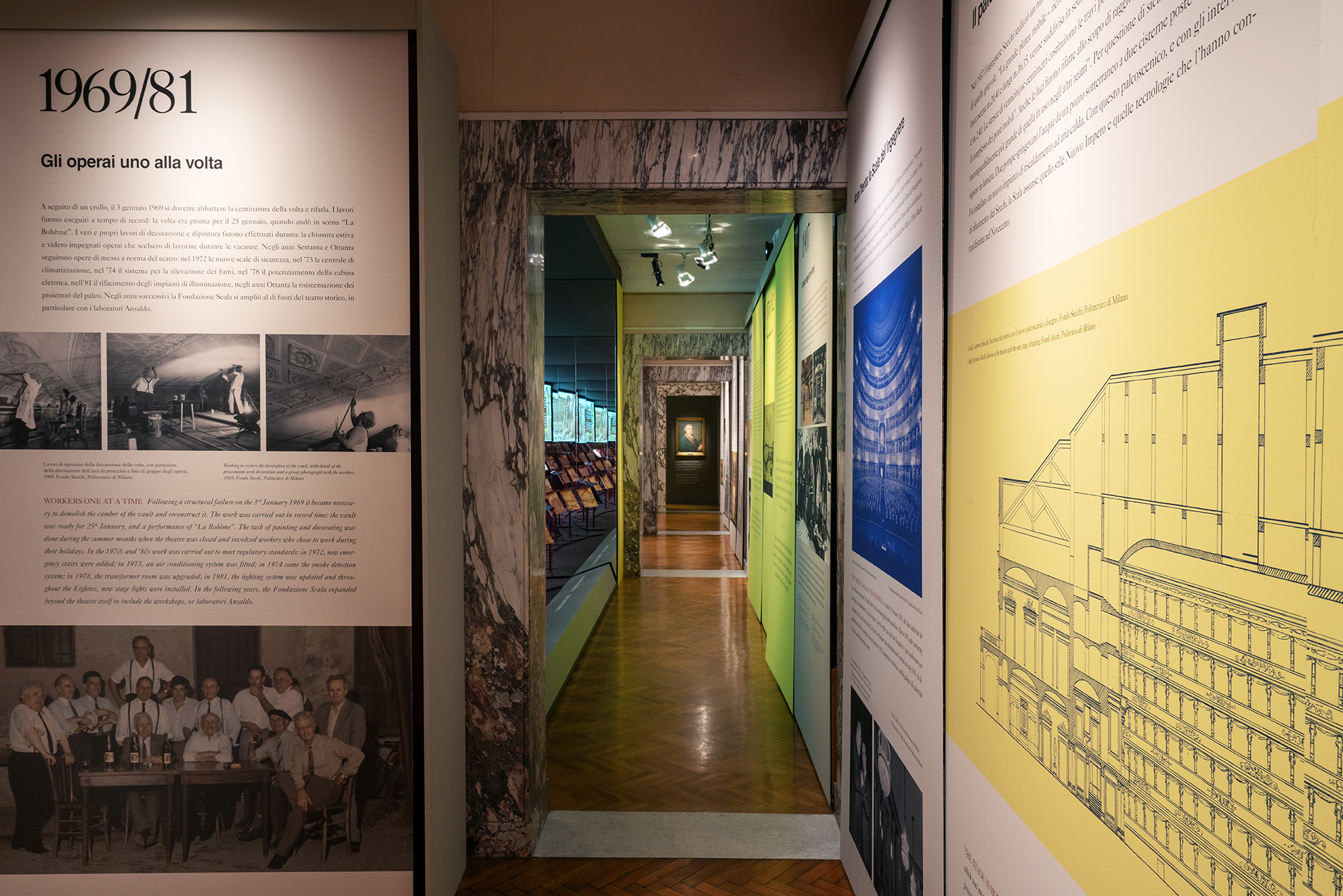La Magnifica Fabbrica. 240 Years of Teatro alla Scala, from Piermarini to Botta. Milan
Exhibition.
Environmental Graphics.
Lighting.
Video.
Museo Teatrale alla Scala / Largo Ghiringhelli, 1. Milan / December 2018 / Museo Teatrale alla Scala
La Magnifica Fabbrica. 240 Years of Teatro alla Scala, from Piermarini to Botta. Milan
Exhibition.
Environmental Graphics.
Lighting.
Video.

Museo Teatrale alla Scala / Largo Ghiringhelli, 1. Milan / December 2018 / Museo Teatrale alla Scala
The exhibition, supported by Intesa Sanpaolo and designed by Italo Lupi, Ico Migliore and Mara Servetto inside the Museo Teatrale alla Scala, allows the visitors to retrace the evolution of the Theater and the city of Milan from the 18th century up today.The real strength of this project lies in its polyphonic character: not only in reference to the capacity of re-organising the complexity of contents and instruments and of transforming them into narration, but also in that this is a project that has been developed by three individuals. “This time too, as with the many projects we have worked on together, we started from the wealth of contents in order to identify a clear and shared feature of the exhibition, to be divided into memorable narrative and experiential scenarios” says Ico Migliore.
The exhibition, curated by Fulvio Irace and Pierluigi Panza and with the partnership of Mape and Edison, allows the public to enter the stories of La Scala and of the city of Milan through a series of micro stories that succeed one another along the six rooms of the Museo and within the Ridotto dei Palchi.
For visitors, stepping through the different space is, in fact, entering the chapters of a book, the off-scale pages of which aregraphically blown up on the walls of a landscape of environmental graphics.
The pace then changes and encounters a moment of theatricality in the room in which the metaphor of an orchestra comes to life. In fact, here the visitor encounters an ensemble of 30 music stands to go with as many historical and present-day pictures of La Scala, which are animated in a round, each time with a differing focus, in dialogue with the large projection above them. This moment strongly encapsulates the historical evolution of the theatre and the piazza in front of it, which has combined the various elements featured in the exhibition in an engaging imposes a change in the visit and in the perspective.
Finally, in the Ridotto dei Palchi, is the final chapter of the story. Here, in fact, an impressive wooden maquette crafted by the Swiss Ivan Kunz recreates with an extraordinary level of construction details, a section of the building at a scale of 1:75 offering the possibility of entering the structure. The visitor can thus explore the transformations from different perspectives, from Piermarini’s designs in 1778 up to the most recent planning history by Mario Botta: the intervention made in 2004 that led to a change in the building’s function and the impending expansion planned for 2022 that will add a new tower to the theatre’s profile. Everything is accompanied by in-depth descriptions and supporting graphics and is marked by dynamic involvement, thanks to a system of augmented reality that relies on the visitors’ curiosity to build further personal moments of discovery. The union of artisanal know-how and technology allows the model to ‘speak’ to visitors, who can thus enter a three-dimensional reality, exploring the evolution of the theatre like modern Lilliputians. Historical data and many curiosities thus support the narrative in a clear example of a targeted, almost “humanistic” use of technology that is not conceived as an aim or as a dramatic effect, but which is instead skilfully calibrated to serve the design and the story underpinning it. A subtle bridge between the real and the virtual that contributes to making the visit unique. An essential condition in our contemporary society, and especially in a space, such as the Museo del Teatro alla Scala, in itself an original exhibit, which from the frame becomes the object of the narrative to recount La Scala from within La Scala.
Photo by Andrea Martiradonna











The exhibition, supported by Intesa Sanpaolo and designed by Italo Lupi, Ico Migliore and Mara Servetto inside the Museo Teatrale alla Scala, allows the visitors to retrace the evolution of the Theater and the city of Milan from the 18th century up today.
The real strength of this project lies in its polyphonic character: not only in reference to the capacity of re-organising the complexity of contents and instruments and of transforming them into narration, but also in that this is a project that has been developed by three individuals. “This time too, as with the many projects we have worked on together, we started from the wealth of contents in order to identify a clear and shared feature of the exhibition, to be divided into memorable narrative and experiential scenarios” says Ico Migliore.
The exhibition, curated by Fulvio Irace and Pierluigi Panza and with the partnership of Mape and Edison, allows the public to enter the stories of La Scala and of the city of Milan through a series of micro stories that succeed one another along the six rooms of the Museo and within the Ridotto dei Palchi. For visitors, stepping through the different space is, in fact, entering the chapters of a book, the off-scale pages of which aregraphically blown up on the walls of a landscape of environmental graphics. The pace then changes and encounters a moment of theatricality in the room in which the metaphor of an orchestra comes to life. In fact, here the visitor encounters an ensemble of 30 music stands to go with as many historical and present-day pictures of La Scala, which are animated in a round, each time with a differing focus, in dialogue with the large projection above them. This moment strongly encapsulates the historical evolution of the theatre and the piazza in front of it, which has combined the various elements featured in the exhibition in an engaging imposes a change in the visit and in the perspective.
Finally, in the Ridotto dei Palchi, is the final chapter of the story. Here, in fact, an impressive wooden maquette crafted by the Swiss Ivan Kunz recreates with an extraordinary level of construction details, a section of the building at a scale of 1:75 offering the possibility of entering the structure. The visitor can thus explore the transformations from different perspectives, from Piermarini’s designs in 1778 up to the most recent planning history by Mario Botta: the intervention made in 2004 that led to a change in the building’s function and the impending expansion planned for 2022 that will add a new tower to the theatre’s profile. Everything is accompanied by in-depth descriptions and supporting graphics and is marked by dynamic involvement, thanks to a system of augmented reality that relies on the visitors’ curiosity to build further personal moments of discovery. The union of artisanal know-how and technology allows the model to ‘speak’ to visitors, who can thus enter a three-dimensional reality, exploring the evolution of the theatre like modern Lilliputians. Historical data and many curiosities thus support the narrative in a clear example of a targeted, almost “humanistic” use of technology that is not conceived as an aim or as a dramatic effect, but which is instead skilfully calibrated to serve the design and the story underpinning it.
A subtle bridge between the real and the virtual that contributes to making the visit unique. An essential condition in our contemporary society, and especially in a space, such as the Museo del Teatro alla Scala, in itself an original exhibit, which from the frame becomes the object of the narrative to recount La Scala from within La Scala.
Photo by Andrea Martiradonna













